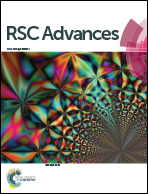Formation mechanism and optical properties of CdMoO4 and CdMoO4:Ln3+ (Ln = Pr, Sm, Eu, Dy, Ho and Er) microspheres synthesized via a facile sonochemical route†
Abstract
In the present work, large-scale uniform CdMoO4 and CdMoO4:Ln3+ (Ln = Pr, Sm, Eu, Dy, Ho, Er) microspheres have been successfully synthesized via a facile sonochemical route. XRD, FE-SEM, EDS, the Brunauer–Emmett–Teller (BET) surface area, and photoluminescence (PL) spectra were used to characterize the samples. The results show that the CdMoO4:Ln3+ can be directly indexed to the tetragonal CdMoO4 phase with high purity. The influence of the reaction time and reactants on the size and shapes of the CdMoO4 microspheres has been studied, and the results revealed that the ultrasonication time and reactants play a crucial role in determining the final morphologies of the samples. Additionally, the PL properties of the CdMoO4 and CdMoO4:Ln3+ (Ln = Pr, Sm, Eu, Dy, Ho and Er) microspheres were investigated in detail. It can be seen that the CdMoO4:Pr3+, Sm3+, Eu3+, Dy3+, Ho3+ and Er3+ samples are located in the red, yellow, red, white, yellow and green regions, respectively. Simultaneously, this novel and efficient pathway could open new opportunities for further investigating the properties of molybdate materials.


 Please wait while we load your content...
Please wait while we load your content...